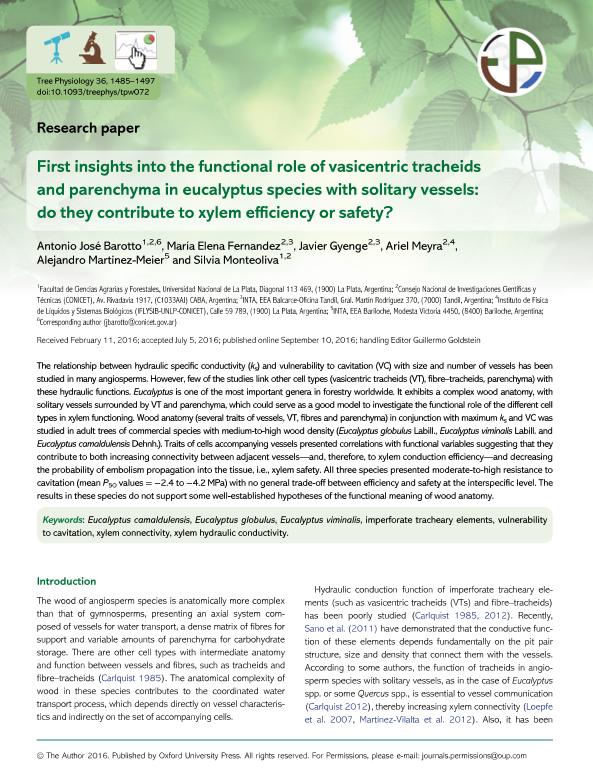Artículo
First insights into the functional role of vasicentric tracheids and parenchyma in eucalyptus species with solitary vessels: Do they contribute to xylem efficiency or safety?
Barotto, Antonio José ; Fernandez, Maria Elena
; Fernandez, Maria Elena ; Gyenge, Javier Enrique
; Gyenge, Javier Enrique ; Meyra, Ariel German
; Meyra, Ariel German ; Martinez Meier, Alejandro; Monteoliva, Silvia Estela
; Martinez Meier, Alejandro; Monteoliva, Silvia Estela
 ; Fernandez, Maria Elena
; Fernandez, Maria Elena ; Gyenge, Javier Enrique
; Gyenge, Javier Enrique ; Meyra, Ariel German
; Meyra, Ariel German ; Martinez Meier, Alejandro; Monteoliva, Silvia Estela
; Martinez Meier, Alejandro; Monteoliva, Silvia Estela
Fecha de publicación:
07/2016
Editorial:
Oxford University Press
Revista:
Tree Physiology
ISSN:
0829-318X
Idioma:
Inglés
Tipo de recurso:
Artículo publicado
Clasificación temática:
Resumen
The relationship between hydraulic specific conductivity (ks) and vulnerability to cavitation (VC) with size and number of vessels has been studied in many angiosperms. However, few of the studies link other cell types (vasicentric tracheids (VT), fibre–tracheids, parenchyma) with these hydraulic functions. Eucalyptus is one of the most important genera in forestry worldwide. It exhibits a complex wood anatomy, with solitary vessels surrounded by VT and parenchyma, which could serve as a good model to investigate the functional role of the different cell types in xylem functioning. Wood anatomy (several traits of vessels, VT, fibres and parenchyma) in conjunction with maximum ks and VC was studied in adult trees of commercial species with medium-to-high wood density (Eucalyptus globulus Labill., Eucalyptus viminalis Labill. and Eucalyptus camaldulensis Dehnh.). Traits of cells accompanying vessels presented correlations with functional variables suggesting that they contribute to both increasing connectivity between adjacent vessels—and, therefore, to xylem conduction efficiency—and decreasing the probability of embolism propagation into the tissue, i.e., xylem safety. All three species presented moderate-to-high resistance to cavitation (mean P50 values = −2.4 to −4.2 MPa) with no general trade-off between efficiency and safety at the interspecific level. The results in these species do not support some well-established hypotheses of the functional meaning of wood anatomy.
Archivos asociados
Licencia
Identificadores
Colecciones
Articulos(CCT - MAR DEL PLATA)
Articulos de CTRO.CIENTIFICO TECNOL.CONICET - MAR DEL PLATA
Articulos de CTRO.CIENTIFICO TECNOL.CONICET - MAR DEL PLATA
Citación
Barotto, Antonio José; Fernandez, Maria Elena; Gyenge, Javier Enrique; Meyra, Ariel German; Martinez Meier, Alejandro; et al.; First insights into the functional role of vasicentric tracheids and parenchyma in eucalyptus species with solitary vessels: Do they contribute to xylem efficiency or safety?; Oxford University Press; Tree Physiology; 36; 12; 7-2016; 1485-1497
Compartir
Altmétricas



